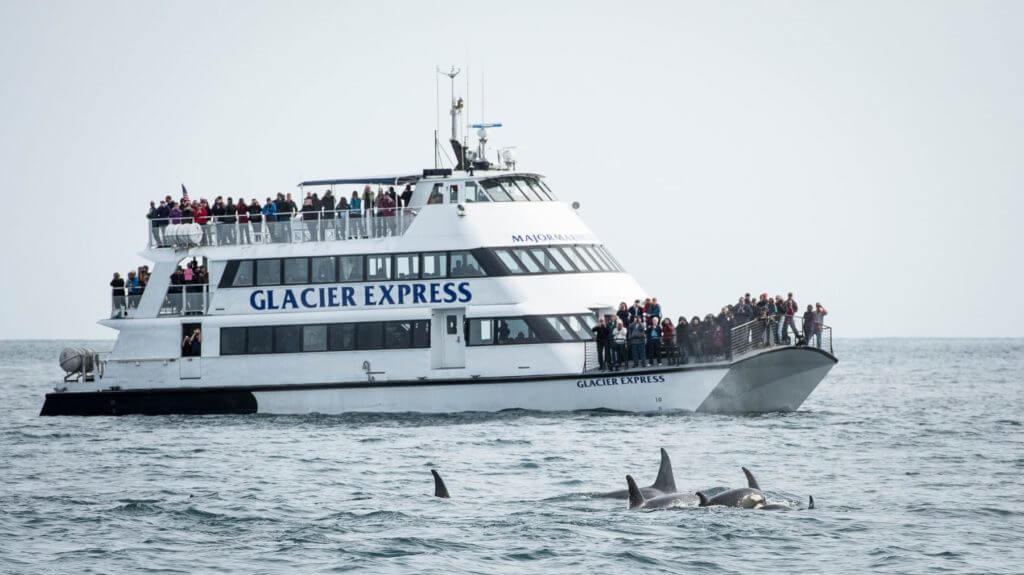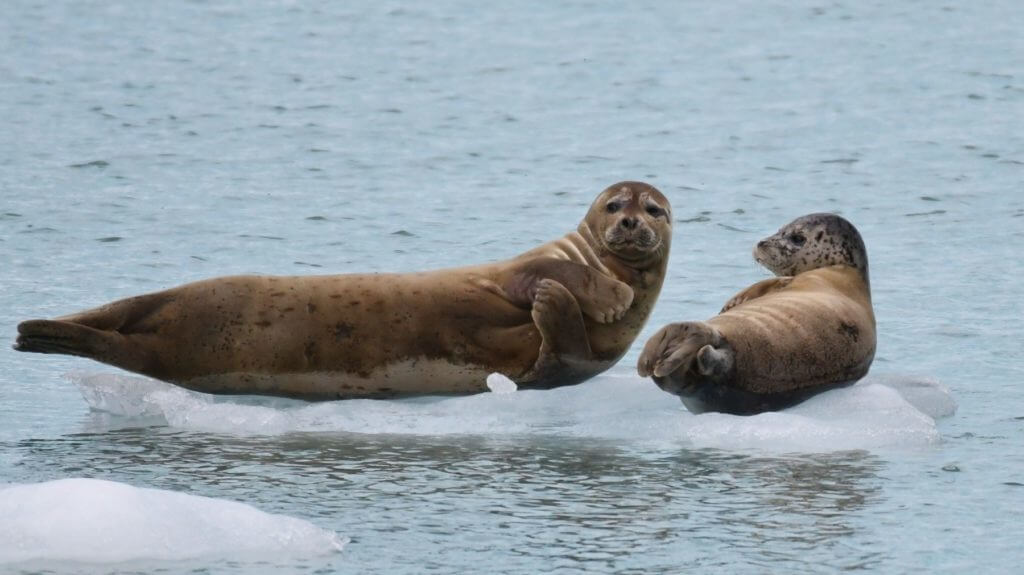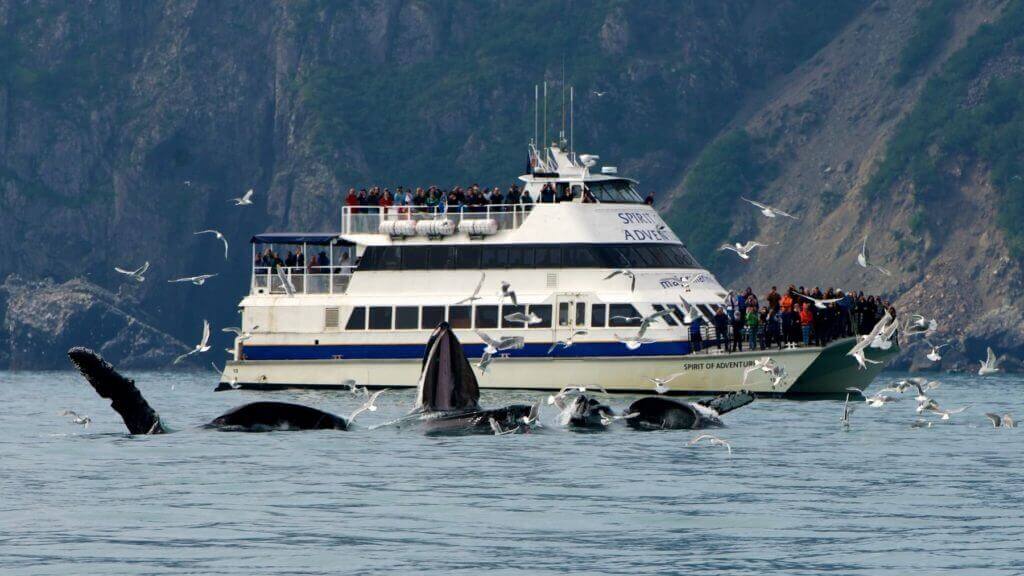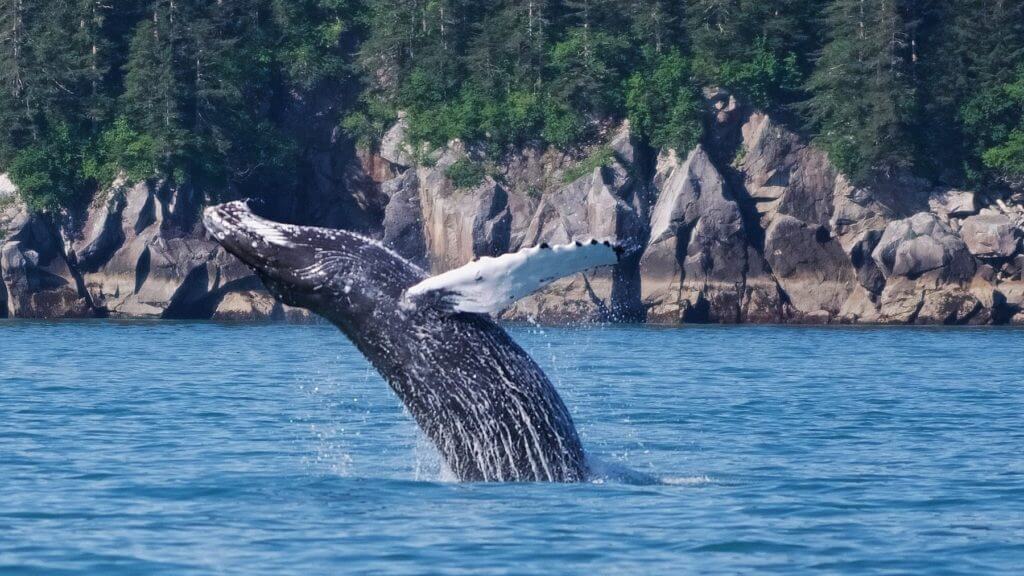Anticipation turned the air to chop as the captains and crew of Major Marine Tours walked through the glass doors of Seward’s Rae building, one carpool emptying after another, all of us gathered in from our separate projects to learn together about our new partner, Whale SENSE. Whale SENSE, an organization under the NOAA umbrella, had just come to Resurrection Bay, and we were here to learn what role the organization would play in the coming summer.
Here is what I knew: Whale SENSE existed to promote responsible whale watching by holding its participants to a standard of non-invasive viewing practices, sound education, and stewardship. Born among whale-watching companies on the East Coast, Whale SENSE had made the migration to Juneau two years ago, and was now continuing their Alaskan expansion into Resurrection Bay and the surrounding Kenai Fjords. Major Marine Tours’ commitment to respectful and responsible wildlife viewing made the partnership an easy choice, but the mass of crew didn’t yet know what form that partnership would take. That was what today was about.

The meeting time drew near, and we moved together from the foyer to the stadium seating where a PowerPoint stood ready. On the way I stopped to gather a few educational materials: a cut-out of a beluga with a number to call in case of sightings of the three hundred and forty beluga left in the Cook Inlet, and an identification card displaying every species of marine mammal common to Alaskan waters, with whales on the front and seals/sea lions on the flip side.
Before learning about Whale SENSE, however we were in for another treat from NOAA: a two-part talk about harbor seals and Steller sea lions, put together by a biologist from NOAA. First, she outlined current research regarding the impact of boats on harbor seals in glacial fjords, detailing the distance at which harbor seals are most likely to flush into the water and the effect that this time spent in the water had on the energy balance of young pups. Afterwards, she spoke about the life-saving rescue operations her team had performed on seven entangled Steller sea lions, an endangered species at home in the waters near Seward, and urged us to contact rescue agencies whenever we saw entangled animals over the course of our trips.
Captains and naturalists from Seward chimed in with the results from other harbor seal studies within the Kenai Fjords, and as I listened I noted again how invested we as a community of tour operators were in the well-being of the animals with whom we shared these stunning waters. I held in my mind the image of a pair of harbor seals on a raft of ice beneath Aialik Glacier, viewed through a set of complimentary Major Marine Tours binoculars, as I traveled from group to group of bundled jackets showing guests the distant animals. The gasp of discovery as guests found these animals had felt just as rewarding as the warmth of knowing the seal’s safety. I had felt grateful to the captain for his distance, grateful to the naturalist for his silence, grateful to the guests for their clear understanding that the well-being of the animals was our priority, and grateful that I had the chance to witness this love for the ocean environment ignite in each of our guests.

Finally, the speaker from Whale SENSE rose to the podium. “Turn your marine mammal card over,” I whispered to my fellow crew member Andy, a friend of the sort with whom I can spend an evening searching for sandhill cranes, and we flipped our handouts from sea lions to whales.
A mic clicked, and the talk began. “Whale SENSE stands for: Sticking to regional whale-watching guidelines, Educating naturalists, captains, and passengers to have SENSE while watching whales, Notifying the appropriate networks of whales in distress, Setting examples for other boaters, and Encouraging ocean stewardship.” Our speaker smiled. “The government loves its acronyms.”
She went on to describe the criteria a company must meet in order to be certified as a Whale SENSE participant. In addition to enacting the practices of Whale SENSE, all captains, crew, and naturalists must complete online or in-person training on safe and respectful whale viewing, and must also complete a stewardship project.

I thought back on how Major Marine Tours’ stewardship project had proceeded the demands of the program. For years now, Major Marine Tours had sold USBs onboard with pre-loaded photos of wildlife to support the Alaska Sealife Center, a phenomenal educational resource in Seward and the leading marine mammal rescue and rehabilitation center in Alaska. Major Marine Tours also donated yearly trips to the Seward Middle School, allowing local children to spend a day on the water learning the beauty of home waters that were worth protecting. It said something, I decided, that Major Marine Tours had donated their time and resources to encourage the love of the ocean long before being required to do so. The criteria of Whale SENSE had come about naturally within the natural beauty that Major Marine Tours worked to protect.
Still, it was helpful to get the entire crew, old and new, on the same page regarding the values that we shared with Whale SENSE, and I settled in for the rest of the talk. The speaker told us about the humpback populations of Alaska, 90% of which came from breeding grounds Hawaii, but 10% of which came from as far away as Mexico or from the endangered breeding population off of Asia and Russia. I studied the charts ferociously, fascinated as always by any new information about these amazing animals. Education plays a powerful role in protection, I remembered, stepping back from my own fascination to think about what passengers must feel when given information about these whales. I had seen it, too, seen the wonder when guests learned about the vast quantity of food humpbacks whales were able to consume per day, or the epic journeys these whales completed each year for the safety of their young calves. Accurate narration was a core of the Whale SENSE platform, and it warmed me to know that, through Whale SENSE, boats around the nation would share the commitment to education that we at Major Marine Tours already enjoyed through our onboard naturalists from Kenai Fjords National Park.

Finally, we got down to the core of the talk, from the perspective of captains and crew: ways to navigate safely around whales without disrupting their behavior. As someone who distinctly remembers being ten years old in a one-piece bathing suit on a beach in California, yelling at the kids who were swimming out towards a pod of coastal bottlenose dolphins that they were in violation of the marine mammal protection act if they approached within 100 yards, I take the protection of marine life very much to heart. From that perspective, I very much appreciated the concise diagrams detailing how to approach whales which, if old practice to the captains, was at least food for thought for the new crew. The discussion that followed showed again that the boats had this type of protection very much in mind, as captains from competing tour agencies engaged in discussions of how to best act around whales.

With that, the talk finished, but a few of us were so interested that we stuck around for the rest of the day to hear speakers from the Chugach National Forest and the Alaska Maritime Refuge, both of which helped solidify information about surrounding agencies who also made the care of wildlife a priority, and which I was excited to pass on to passengers. The highlight was a reminder from an Alaska Maritime Refuge speaker that the composition of species in the area was always in flux, and that with warmer water we should be on the lookout for marine mammals not commonly sighted in these waters, most notably the Guadalupe fur seal, recently sighted in Kachemak Bay, and the blue whales whose range had once extended into the Gulf of Alaska.
I left that evening with a new appreciation for the common goal that an organization like Whale SENSE brought to the whale watching community, a goal which we had all enacted separately but could now pursue alongside tour agencies up and down Alaska’s coast. Knowing that Major Marine boats set out into an ocean rich with knowledge and respect makes it ever so much more meaningful when we approach whales that we know will continue to be treated with respect, both while we travel with them and after we depart.
And it is on those trips that the core ideal of Whale SENSE becomes true. When a humpback whale surfaces beyond a deck silent with anticipation, when guests can do no more than whisper “wow,” then I know that every person on that boat has been struck with the awe that precedes protection. To love something, you must know it, and on every Major Marine trip the knowledge our captains bring only helps them to pass their love of the animals on to each person on the deck. It is the care that Major Marine Tours brings to each trip that takes us straight to the heart of what Whale SENSE means, and it is because of that care that over two decades of passengers have had the chance to engage with the stunning creatures of Resurrection Bay and the Kenai Fjords. Have had the chance to love them. And have passed that care on, in each brightened eye or wistful remembrance of water streaming off a raised fluke, to a nation that cares that much more about the whales that share their waters.
Tamara Lang is a returning deckhand with Major Marine Tours in Seward. She is a writer of creative nonfiction and the author of “Upstream: A Written and Photographic Journey up the Los Angeles River.” Her writing and her travels can both can be followed on Facebook at Tamara Lang Writes, or at tamaralang.com.
To learn more about the Whale SENSE program, please visit the Whale SENSE website.

Signup for our newsletter to get the most recent Major Marine updates.